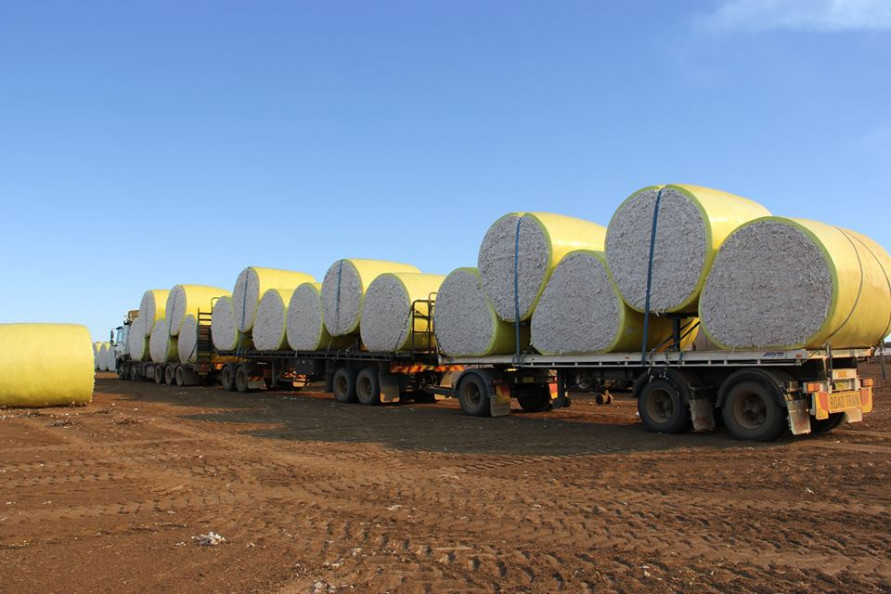Australia's cotton production has been halved this season with drought and low-to-no water allocation for most growers taking a toll on crops.
While cotton picking and ginning was still underway throughout New South Wales and Queensland, Cotton Australia chief executive Adam Kay forecast the 2018/19 national crop would be around 2.1 million bales.
"It will still generate about $1.5 billion dollars worth of export income, but production is less than half of the previous season and we expect next season it will halve again," Mr Kay said.
"It's been a tough year, and there was this idea that cotton was somehow not impacted by drought — it's not right, the crop size halved, and it's been a very difficult year."
Mr Kay said water availability had driven yields down, which ranged from seven to 14 bales a hectare for irrigated cotton crops.
Reduced supply will not drive price hike
Mr Kay said, while cotton production was reduced in Australia this year, growers should not expect the price to lift.
"Australia only contributes to about 4 per cent of the global market," he said.
"So if we drop a per cent or so this year with production, it's not going to really impact the global market.
"Our small production isn't going to swing global prices one way or another."
Mr Kay said increased cotton plantings in the United States this year could in fact reduce the cotton price for Australian growers.
Cotton in Australia was currently worth about $580 a bale, with cotton seed returning about $400 a tonne.

State of play for cotton
In Queensland, cotton picking is near complete with below average yields reported — particularly from the Darling Downs.
Mr Kay said standout crops had been at Theodore in the Dawson Valley.
In northern NSW, growers with dryland cotton were disappointed with the season.
"One fifth of the crop was ploughed in and what had been picked was well below average," Mr Kay said.
Moree agronomist Tony Lockrey said most dryland growers would not make more than two bales a hectare.
"We had just enough rain in spring to get it in, but had little follow-up rain to carry it through due to the record heat," Mr Lockrey said.
Mr Kay said some irrigators in northern NSW had planted more cotton than they had water for.
"They thought there would have been more rain through the season with some inflows, but when that didn't happen they fell short with water and that impacted yields," he said.
In southern NSW, growers, particularly in the Murrumbidgee Valley and Murray Valley where general security water allocations were 7 and 0 per cent respectively, were more conservative with the area they committed at planting time.
He said yields from the Lachlan Valley in the NSW central west and the Murrumbidgee and Murray Valleys were average.
Mr Kay said, across states, the quality of irrigated crops was mostly good, however there had been some reports of high micronaire.
Dryland crop quality was greatly affected with heavy discounts at ginning applied due to the effect drought had on fibre length.
Drought will not stop progress
Despite the tough season, plans for a new cotton gin in southern NSW are going ahead.
Southern Cotton, which operates a gin at Whitton in the Riverina, is planning to open a second gin at Coleambally by late 2020.
General manager Kate O'Callaghan said they would gin 190,000 bales at the Whitton site this season — on par with their average throughput — but well back on the 250,000 bales it ginned last season.
Ms O'Callaghan said another gin would allow them to process 180,000 bales at each gin.
"It will allow us to pay growers quicker as they won't have to wait as long for their cotton to be ginned," she said.
As for the current crop being picked and ginned, Ms O'Callaghan said yields were varied due to a lack of rain and irrigation water during the growing season and rain at picking time.
Yields across the Murrumbidgee and Murray Valleys ranged from eight bales per hectare to 13 bales per hectare.
"There were some growers who didn't have any water and couldn't put a crop in," Ms O'Callaghan said.
"But most growers who had 7 per cent water allocation also had 30 per cent carryover water, which meant they had 37 per cent water this season.
Mr Kay was hopeful winter rainfall and inflows would improve growing conditions in Australia for spring planting.
"The water situation is quite gloomy at the moment, but we have seen these situations before and it can turn around quite quickly," he said.
Ms O'Callaghan said rain was needed throughout winter to set up the 2019/2020 growing season.
"It will rain eventually, we will be talking about a flood before we know it," she said.


